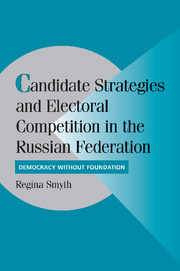 Candidate Strategies and Electoral Competition in the Russian Federation
Candidate Strategies and Electoral Competition in the Russian Federation Book contents
- Frontmatter
- Contents
- 1 ELECTIONS AND THE DEVELOPMENT OF DEMOCRATIC CAPACITY
- 2 ONE STEP FORWARD, TWO STEPS BACK: RUSSIA'S FAILED CONSOLIDATION IN COMPARATIVE CONTEXT
- 3 THE MICROFOUNDATIONS OF DEMOCRATIC RESPONSIVENESS: CANDIDATE STRATEGIES AND ELECTORAL INFRASTRUCTURE
- 4 MANY CANDIDATES, FEW CHOICES
- 5 TO JOIN OR NOT TO JOIN: CANDIDATE AFFILIATION IN TRANSITIONAL RUSSIA
- 6 FINDING FIT: CANDIDATES AND THEIR DISTRICTS
- 7 CAMPAIGNING FOR THE DUMA: MIXED MARKETS, MIXED MESSAGES
- 8 DEMOCRATS, DEMOCRATIC TRANSITIONS, AND RUSSIAN DEMOCRACY
- Appendix A The Sample
- Appendix B The Candidate Survey
- Appendix C Variables Constructed from Survey Data
- Appendix D Sample and Variable Construction for Analysis in Chapter 2
- Works Cited
- Index
- Cambridge Cultural Social Studies
6 - FINDING FIT: CANDIDATES AND THEIR DISTRICTS
Published online by Cambridge University Press: 25 July 2009
- Frontmatter
- Contents
- 1 ELECTIONS AND THE DEVELOPMENT OF DEMOCRATIC CAPACITY
- 2 ONE STEP FORWARD, TWO STEPS BACK: RUSSIA'S FAILED CONSOLIDATION IN COMPARATIVE CONTEXT
- 3 THE MICROFOUNDATIONS OF DEMOCRATIC RESPONSIVENESS: CANDIDATE STRATEGIES AND ELECTORAL INFRASTRUCTURE
- 4 MANY CANDIDATES, FEW CHOICES
- 5 TO JOIN OR NOT TO JOIN: CANDIDATE AFFILIATION IN TRANSITIONAL RUSSIA
- 6 FINDING FIT: CANDIDATES AND THEIR DISTRICTS
- 7 CAMPAIGNING FOR THE DUMA: MIXED MARKETS, MIXED MESSAGES
- 8 DEMOCRATS, DEMOCRATIC TRANSITIONS, AND RUSSIAN DEMOCRACY
- Appendix A The Sample
- Appendix B The Candidate Survey
- Appendix C Variables Constructed from Survey Data
- Appendix D Sample and Variable Construction for Analysis in Chapter 2
- Works Cited
- Index
- Cambridge Cultural Social Studies
Summary
It was a major mistake running outside of the oblast capital. I didn't consider the local bosses. Of course, they would influence outcomes.
Yabloko candidate, 1999Democratic governance is built on stable and reciprocal relationships between representatives and their constituents, typically mediated through political party organizations. To understand how candidates' decisions shape mass opportunities to press demands on government, insist on responsiveness, and provoke accountability, this chapter moves to the next step in a candidate's electoral calculus: where to run (which district) and, in the case of partisans, how to run (whether to run on a party list, only in a district, or in both races).
For Russian candidates, district selection is a real choice. Since 1993, the electoral law has codified two types of districts: 225 single-member (“nominal”) districts, and a national (party list) district based on proportional representation. The national district race is characterized by a number of potential national constituencies rooted in common interests or identities. A number of institutional elements, including the relatively stringent 5 percent threshold and the regulations governing the registration of political parties, serve to dissuade regional interests from entering into the party list race. In contrast, the nominal or single-member districts capture geographically based constituencies that encapsulate different combinations of political, economic, ideological, or ethnic interests. As a result, Russian candidates face a broad and complex range of constituencies – potential electoral markets – in each election.
- Type
- Chapter
- Information
- Candidate Strategies and Electoral Competition in the Russian FederationDemocracy without Foundation, pp. 131 - 164Publisher: Cambridge University PressPrint publication year: 2006


